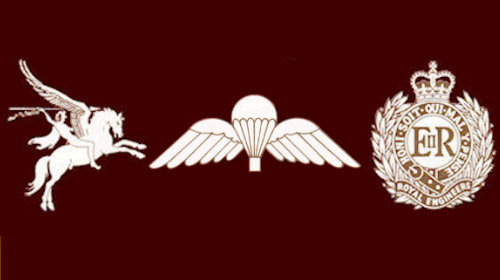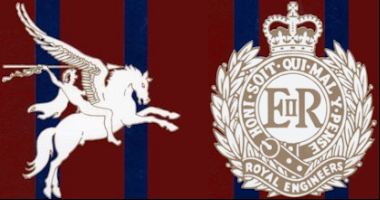
Roll of Honour

John (Jack) Hobbs
John (Jack) Hobbs 29 May 1920 — 08 June 2010
 |
Jack was South London born and the youngest of eight children. As a boy he enjoyed helping his father in the family shop where they made barrows. It was no surprise, then, that Jack enjoyed carpentry or that this early talent would eventually lead to his taking up this trade in the Royal Engineers, especially as, when he left school, he worked for a year in a factory making ash and beech-wood tennis rackets. He was a lively young lad and he would often recall how he would cycle or run over all the bridges across the River Thames and go swimming after school, jumping into the Thames from Lambeth Bridge. Jack joined the Territorial Army in 1936 and he served with the 5th Royal Berkshires in the retreat to Dunkirk. Later in 1940 he transferred to the Royal Engineers where, initially, he served in 502 Field Company on Bomb Disposal Duties. Fit, keen and always on the lookout for something different, Jack was one of the first volunteers for Airborne forces and, in 1941, he was a founder member of the 1st Air Troop RE — the first Royal Engineers' Airborne unit. It was not long before the 1st Air Troop expanded to become 1st Parachute Squadron but the early volunteers of the 1st Air Troop never forgot — or let it be forgotten - that they were in the vanguard of those who earned what was to become the awesome reputation that The (always 'The') Squadron was to earn for itself during World War II. |
Jack always regretted that he missed the Bruneval Raid because he was on a small arms training course at Bisley at the time, but he fought with The Squadron in North Africa, Sicily and Italy. When The Squadron departed for Arnhem, Jack was frustrated to be nominated for the Sea Party and to miss this battle. However, he re-joined the remnants of 1st Airborne Division in Holland and went with the Division to liberate Norway in 1945. In May 1995 he was invited to attend the 50th Anniversary of the liberation in Oslo and was honoured to have been introduced to the King of Norway. (He always boasted that he also thoroughly enjoyed sampling the salmon and reindeer that was on the celebration menu!)
Jack joined the Territorial Army in 1936 and he served with the 5th Royal Berkshires in the retreat to Dunkirk. Later in 1940 he transferred to the Royal Engineers where, initially, he served in 502 Field Company on Bomb Disposal Duties. Fit, keen and always on the lookout for something different, Jack was one of the first volunteers for Airborne forces and, in 1941, he was a founder member of the 1st Air Troop RE — the first Royal Engineers' Airborne unit. It was not long before the 1st Air Troop expanded to become 1st Parachute Squadron but the early volunteers of the 1st Air Troop never forgot — or let it be forgotten - that they were in the vanguard of those who earned what was to become the awesome reputation that The (always 'The') Squadron was to earn for itself during World War II.
Jack always regretted that he missed the Bruneval Raid because he was on a small arms training course at Bisley at the time, but he fought with The Squadron in North Africa, Sicily and Italy. When The Squadron departed for Arnhem, Jack was frustrated to be nominated for the Sea Party and to miss this battle. However, he re-joined the remnants of 1st Airborne Division in Holland and went with the Division to liberate Norway in 1945. In May 1995 he was invited to attend the 50th Anniversary of the liberation in Oslo and was honoured to have been introduced to the King of Norway. (He always boasted that he also thoroughly enjoyed sampling the salmon and reindeer that was on the celebration menu!)
Jack was demobbed in 1946 and returned to his work as a Carpenter with Copes building firm in London: a job he was to enjoy for the next twenty years. Some of the projects that benefitted from his skill as a tradesman included the conversion of the Windmill Theatre into a cinema, making a bow-fronted addition to the box office at the Aldwych Theatre and the construction of a timber ceiling at Caxton Hall. If you are ever in any of these places, look around. His handiwork is still to be seen.
From carpentry Jack moved on to become a surveyor with Westminster City Council. Among the buildings he was responsible for were a number of residential homes for children and adults. It was no surprise to note that this warm, kind-hearted and dedicated man, was greatly loved and respected by the staff and residents of these homes, not only for his work but also for the extra ways that he always tried to help all of those with whom he came into contact.
Jack remained a staunch member of the 1st Parachute Squadron Club and, while his health allowed, he never missed an annual reunion. He also made a lasting contribution to the Squadron by using his painstaking Carpentry skills to make the Memorial Lectern in Donington Church.
Sadly Jack's wife, Grace, died within a few years of his retirement in 1984 and they were denied the long years of travel and fun that they had hoped to spend together. He always missed Grace but, having five loving daughters and a host of grandchildren, together with active memberships of the Petts Wood Branch of the British Legion, the Eltham and Chislehurst Branches of the Parachute Regimental Association and the Birmingham Branch of the AEA, Jack was never idle and he enjoyed a fulfilling retirement. He was a proud family man and it gave him immense pleasure to be surrounded by his family to celebrate his 90th birthday just a few days before he died.
He will be fondly remembered by his family, his wide circle of friends and by his comrades in the 1st Parachute Squadron.
All are the richer for having known and revered such a man.












